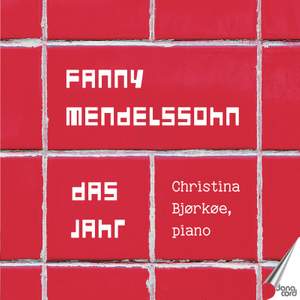
Fanny Mendelssohn (1805-1847)
Das Jahr – 12 Charakterstücke für Klavier (1841)
Christina Bjørkøe (piano)
rec. 2021/2022 at the Danish National Academy of Music, Odense
Danacord DACOCD957 [57]
Glancing through a list of compositions by Fanny Hensel – or Mendelssohn or Mendelssohn-Hensel – one notes a certain anonymity in their titles; 67 that are just Klavierstück – piano piece, music she needed to write but which she knew would not be published. It reflects something of her anonymity as a composer where several of her songs were published under her brother’s name, including one favoured by Queen Victoria it seems. I confess that I only had an earlier disc of Das Jahr and two other short pieces in my collection; based on this new set and what I’ve already heard I am ready and eager to hear more.
Fanny was born 4 years before her celebrated brother and like him was a talented pianist from an early age, playing Bach’s Well-Tempered Klavier from memory just into her teens. She always composed and her husband, the artist Wilhelm Hensel was supportive of her composing. It was in 1841 after an inspiring year-long trip to Italy that she wrote the thirteen pieces that make up Das Jahr, one for each month and an epilogue. Unlike Tchaikovsky’s Months (or Seasons as it is oddly called) which tend to characterise the months themselves or related activities Hensel’s set is more of an evocation of this Italian sojourn and the events and time spent there with family. The booklet notes do not say a lot about the music which is not that much of an issue, the music is here to enjoy but comparing this with the version already in my collection, Lauma Skride on Sony (Sony 88697030162) I noticed some differences. Hensel made some revisions to the collection in 1842 writing an entirely new piece for June and evidently tightened up and trimmed some passages and that is the version that Skride plays. This new recording is of the 1841 version so as well as June in its original version Bjørkøe plays the grandiose closing version of the choral introduced in December, Von Himmel hoch, da komm ich her which Hensel later cut, preferring the quieter segue into the Nachspiel.
January and December were the final two pieces written; January is subtitled A Dream and is like a fantasy, a slow introduction with pre-echoes of music to come, notably May; its solemnity is shattered by sudden presto semiquavers. February is a scherzo, fleet and dashing that was the first to be written – its bustling figuration depicts a Venetian carnival, a clear and enjoyable memory for Hensel. The passionate F-sharp minor melody of March gives way to a choral, Christ ist erstanden written in a very simple style though it is then given the grand treatment, the tune in chords over a full left hand accompaniment. April is a turbulent, virtuosic piece notwithstanding the gentler lilting passages that keep trying to make themselves heard while constantly being interrupted by toccata like figuration so it is left to May to be the breezy and charming spring song. June is a serenade that settles into a barcarolle after a D minor introduction. The figuration grows increasingly complex through the piece but even at the opening Hensel is adopting Sigismund Thalberg’s three hand technique with a tenor line singing out between two accompanying figures. At the end the arpeggios rolling around the melody remind one of the big tune in a Liszt or Thalberg opera fantasy (the alternative that Hensel wrote the following year is considerably less florid). July is one of the simplest in style, a sparse textured melody in F contrasting with an F minor section plagued by low tremolando rumbles, a summer storm that threatens but never arrives in full force. August is offered in two, undated versions; Bjørkøe chooses the second which has more music including a short dramatic interlude before the march proper begins and an extended caprice-like second half that is almost twice the length of the first version. September is subtitled Am Flusse and the river here is represented by a constantly flowing stream of triplets surrounding the beautiful if mournful melody. A hunting song signals October, quite martial at the opening but breaking into the more familiar 6/8 rhythm along the way; for all its virtuosity it is a somewhat episodic piece that strays away from the idea of a straightforward tally-ho across the fields. November is a sad month with slow opening section that has something of Beethoven in its recitative-like dramatic unfolding though the faster second half is all Mendelssohn, fast paced and breathless. The opening semiquavers of December, all quicksilver and elfin, hark back to the Chopin études, in particular the torrential C-sharp minor from Op 10 though here the effect is more of light snow flurrys than the blizzard Chopin conjures. The snow gradually settles and we hear the second of the Bach chorales, firstly in a simple setting then played over slow triplets and finally in the grand iteration that Hensel was to omit in the revised version. Hensel then brings the set to a close with a short epilogue based on another chorale, Das alter Jahr vergangen ist.
I enjoyed Christina Bjørkøe’s performance; she enjoys the contrasts to be found and her playing in lower dynamics is wonderful – just listen to the hushed chromatics before the return to the theme in February. I err towards Skride is some of the more virtuosic passages purely because she has the edge in clarity of fingerwork, rather softer focussed in Bjørkøe’s recording. In the Nachspiel Skride brings a greater contrast between the chorale melody and the bridging material but Bjørkøe is never wanting for character and both recordings are valuable additions to the Hensel discography.
Rob Challinor
Previous review: John France (December 2022)
Help us financially by purchasing from





















